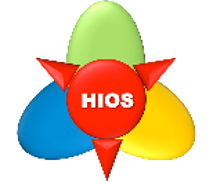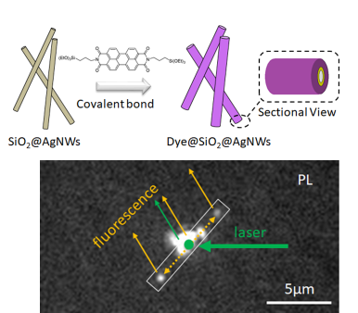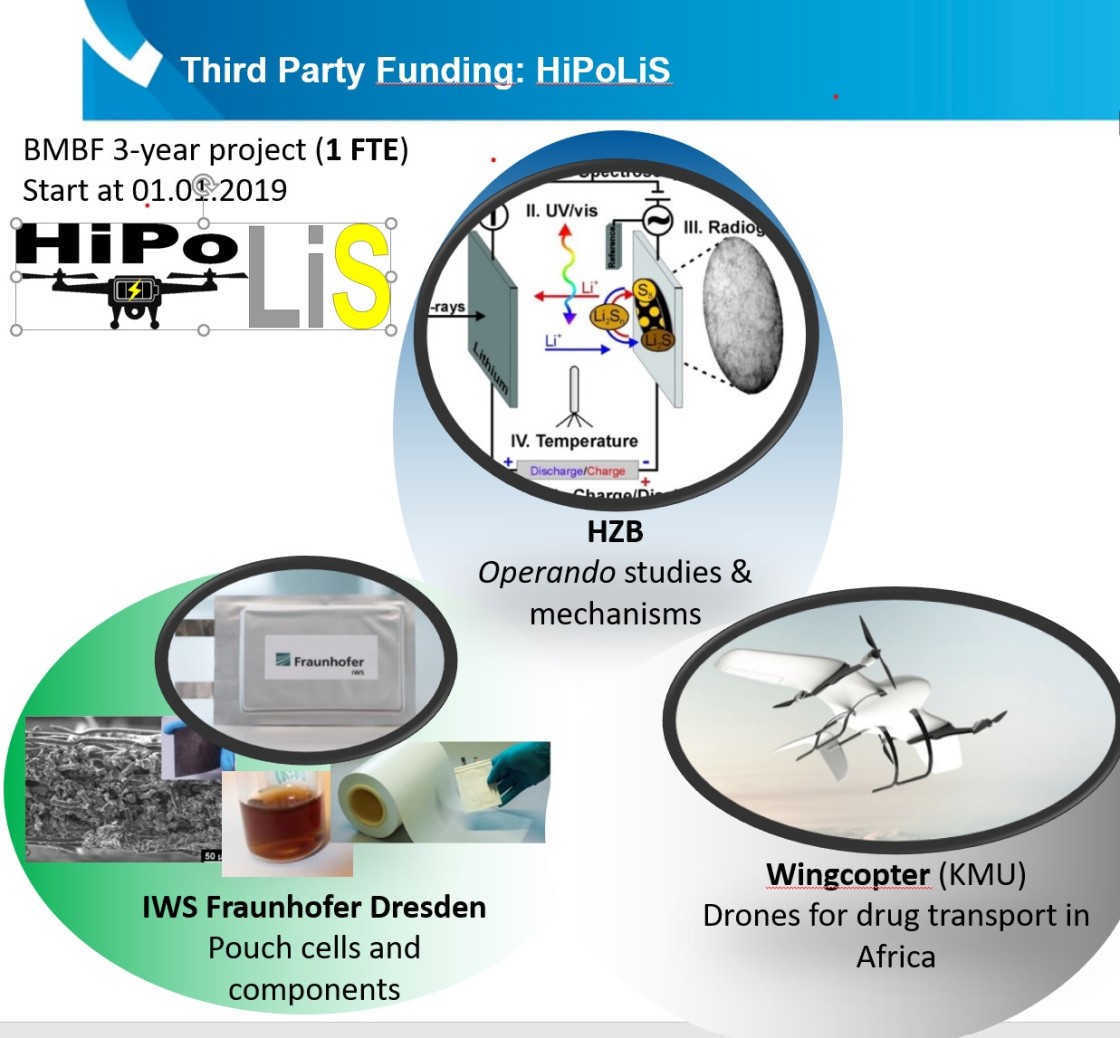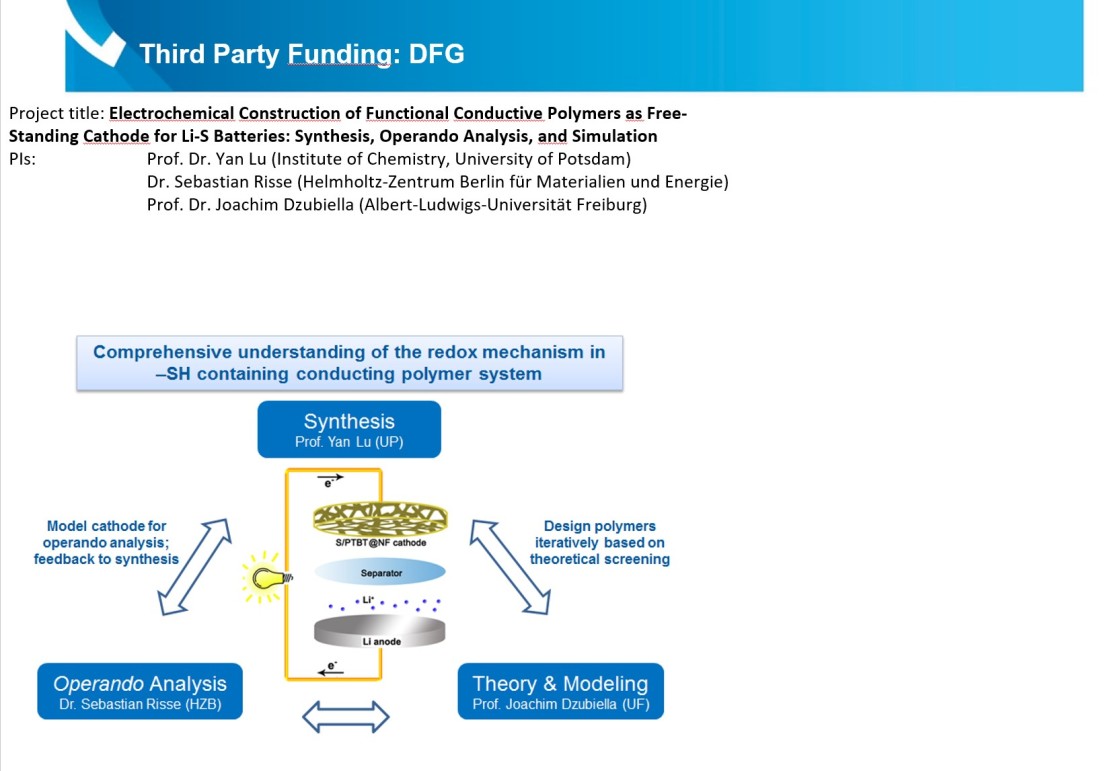Institute Electrochemical Energy Storage
Third funding projects
The central goal of our project is to establish surface plasmon polariton (SPP) directional propagation by a chiral hybrid inorganic/organic system (HIOS). For this a plasmonic antenna-wire system is assembled on a HIOS consisting of a two-dimensional transition metal dichalcogenide and matched conjugated organic molecules. In this model system we will study chirality and circular dichroism on a molecular scale in fundamental HIOS. Furthermore, we will explore concepts for ultra-compact chirality sensors.
Link to HIOS homepage: https://www.physik.hu-berlin.de/de/sfb951
Joint DFG-NSFC project: Hybrid nanostructures based on protein-assembly driven by carbohydrate-protein interactions
PIs: Prof. Dr. Yan Lu (HZB/UP) and Prof. Guosong Chen (Fudan University, China)
By combining the expertise of Lu’s group from HZB/UP in synthesis of hybrid structures and Chen’s group from Fudan University in assembly of protein systems, we aim to develop new hybrid materials based on protein-assembly structures. Both groups have collaborated together for the development of new protein assemblies based on carbohydrate-protein interactions since 2013. Meditated by the small molecule, protein assembled into highly-ordered and uniform structures, including microtubules, 2D nanosheets, crystals etc. However, the mechanism of the above strategy has not been totally understood. In addition, the use of protein assemblies as template/carrier for the formation of hybrid materials with controlled shape has not been reported yet. This will make big progress for the synthesis and possible applications of protein-based hybrid nanostructures, giving strong impact in this field.
Lithium-sulphur (Li/S) battery cells already achieve gravimetric energy densities of up to 400 Wh/kg and are clearly superior to conventional lithium-ion batteries in this respect. Especially flight applications benefit from this advantage and first demonstration projects use Li/S batteries as storage and for the electric propulsion of pseudo-satellites. With the growing market of unmanned aerial vehicles for civil applications (modern agriculture, drug transport), the demand for light, powerful batteries is also increasing.
The use of Li/S cells (350 to 450 Wh/kg) in these aircraft would double the independent flight time compared to lithium-ion cells (150 to 250 Wh/kg), thus allowing significant cost savings and a wider range of applications for the user. However, the low level of technological maturity has so far prevented a broad application of Li/S cells. In addition, little is known about the factors influencing the performance and other application-relevant properties of the cells, so that there is also a need for scientific research. The focus on Li/S cells with a particularly high power density would also lead to a considerable shortening of feedback loops in material development. Thus, especially the improvement in performance holds great potential for bringing Li/S storage technology in general to market maturity more quickly.
The overall objective of the project is therefore to improve the performance of Li/S cells and to demonstrate extended flight time in a prototype flight application. Innovations in cell design, electrode layout and electrolyte system are the solutions to this objective.
In this project, we propose the electrochemical construction, operando characterization as well as theoretical modeling of a conductive, flexible and free-standing cathode with the polymer poly(4-(thiophen-3-yl) benzenethiol) (PTBT) as sulfur host material for lithium sulfur (Li-S) batteries. In particular, PTBT can be deposited on the surface of nickel foam by an electropolymerization method, which enables the application of a highly porous and binder-free cathode for Li-S batteries. Sulfur can be copolymerized with a PTBT film through inverse vulcanization to form highly crosslinked copolymer P(S-PTBT), in which the feed sulfur is chemically bonded to the thiol groups of PTBT. By applying a novel in-house developed operando setup that can perform more than three different measurements simultaneously while the cell is in operation, we plan to gain mechanistic knowledge about important reaction steps, e.g., the process that chemically bonds the sulfur to the polymer backbone during electrochemical oxidation. In particular, UV/vis-, Raman-, and impedance-spectroscopy in combination with either X-ray imaging or small angle scattering will be used.
The experiments will be tightly linked to extensive modeling and simulations efforts on electronic and molecular scales: We will study the stability and the electronic/molecular structure of the sulfur covalently bonded to the thiol-containing neutral and charged polymers using state-of-the-art exchange-correlation functionals in density functional theory (DFT). In order to elucidate the structure-performance relationship of the proposed cathodes, we will compare operando analysis such as UV/vis spectroscopy directly with results from DFT calculations and DFT-optimized, classical molecular dynamics (MD) simulations.
Hence, by the combination of synthesis, operando analysis and simulation, we aim to gain a better mechanistic understanding of the energy storage processes and structure-property-function relationships in this system. This knowledge will be used for a continuous improvement of material parameters that enhance the electrochemical performance next-generation Li-S batteries.








